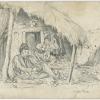‘Bulgarian Settlement’
Commentary
Page featuring an engraving (made after a drawing by Arthur Evans), captioned ‘Bulgarian Settlement’, published in Arthur J. Evans, Through Bosnia and the Herzegóvina on Foot during the Insurrection, August and September 1875 (London, 1876), p.29.
Artist: Unidentified engraver, after an original drawing [1941.8.184] by Arthur John Evans
Date of publication: 1876
Continent: Europe
Geographical area: Southern Europe
Country: Croatia
Region/Place: Zagreb
Cultural group: European Bulgarian
Format: Woodcut engraving
Page size: 234 x 141 mm
Acquisition: Henry Balfour. Bequeathed February 1939
***
Research notes: It has been identified by Philip Grover that this woodcut engraving by an unnamed artist was based on an original drawing [1941.8.184] by Arthur John Evans, being the depiction of two men at a small Bulgarian settlement in Maksimir Park on the outskirts of Zagreb. It was published in Evans’ account of his journey, Through Bosnia and the Herzegóvina on Foot during the Insurrection, August and September 1875 (London, 1876), p.29, printed with the caption ‘Bulgarian Settlement’. Evans recorded in the volume: ‘I had noticed in the market, sitting apart from the light Croat country people, a man selling vegetables of a different kind to the others, with vestments of a duller hue, and on his head a black conical sheepskin cap, which recalled to mind the head-gear of the Bulgarians of the Lower Danube, and sure enough a Bulgarian he turned out to be. On enquiring I found that a small Bulgarian colony had settled near the Archbishop’s Park of Maximir, to tracking out which I devoted my last afternoon at Agram. [...] The colony consisted of two very rude straw-thatched sheds, which seemed all thatch and no wall, insomuch that on approaching them I at first mistook them for two long, irregular haystacks. One of the hovels was for dwelling-house and the other as a shelter for vegetable stores, filled with gherkins and onions, and overgrown by a vine-leaved pumpkin. The dwelling-house had a kind of porch or atrium; that is to say, the thatched eaves, supported by two poles, projected almost as far in front of the door as the one room extended behind it. Under this canopy were seated two Bulgarians, hard at work tying up bundles of onions, clad in their dark national costume - the brown tight-sleeved jacket embroidered with black, the dull red sash, the brown trowser-leggings which are equally Turkish and Tartar, and on their head the black sheepskin cap which had at first attracted my attention; while on a peg behind hung one of their heavy mantles of the same black, shaggy sheepskin. [...] They had come all the way up the Danube and Save to scrape together money by their superior agricultural industry among the lazier Croats, and having brought with them some of their native seeds, were able to expose for sale gherkins of peculiar forms, and finer kinds of onions, in the Agram market’: Through Bosnia and the Herzegóvina on Foot, pp.27, 28–29, 32. Note that Agram is the German name for Zagreb, Croatia.

